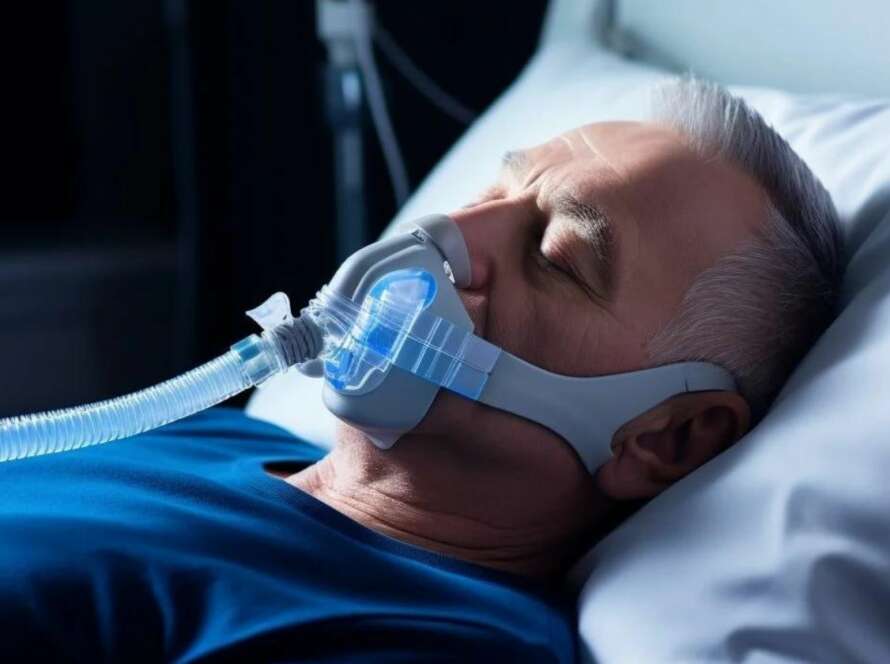Struggling to get a good night’s sleep because of sleep apnea? You’re not alone. Many people face this challenge every night. But don’t worry! Learning how to sleep with sleep apnea can transform those restless hours into peaceful slumber.
Imagine closing your eyes and drifting off easily, breathing comfortably through the night. This dream can become your reality. We’re here to guide you through simple, effective steps to make sleeping with sleep apnea much easier.
Get ready to say goodbye to those sleepless nights and hello to a fresher, brighter morning!
Diagnosing Sleep Apnea
Sleep Study Evaluation
A sleep study can help if you’re having trouble sleeping. Doctors watch how you sleep in this test. They check your breathing and heart while you sleep. This test is done at a hospital or your home.
It shows if you have sleep apnea and helps you find the right treatment.
Symptoms Recognition
Look for signs like loud snoring, tired even after sleeping a lot, or not breathing briefly during sleep. Other clues are waking up with headaches and difficulty paying attention during the day.
Knowing these signs helps you get help quickly.
Consulting A Specialist
Seeing a specialist is important if you notice these signs. This doctor, who knows a lot about sleep problems, will ask about how you sleep and your health. They will tell you to have a sleep study.
This doctor will help you understand your sleep better and what to do next.
Treatment Options
Oral Medical Devices
There are a few ways to make your sleep better. Doctors can suggest ways to keep air moving smoothly for sleep apnea, such as oral medical devices and PAP machines, so you breathe better at night and sleep peacefully.
Lifestyle Modifications
Changing some of your daily habits can also help with sleep apnea. Losing weight can make a big difference if you’re overweight. Avoiding alcohol and smoking helps, too, as these can make sleep apnea worse.
Also, try sleeping on your side instead of your back. Small changes like these can improve your sleep a lot.
Adapting To Changes
Establishing A Routine
Creating a regular bedtime routine can help your body get used to sleeping with sleep apnea treatment. Go to bed and wake up at the same time every day. Make your bedroom comfortable for sleeping: dark, cool, and quiet.
This consistency helps your mind and body prepare for a good night’s sleep.
Managing Side Effects
Sometimes, treatments like oral medical devices/PAP machines can have side effects. You will experience a dry nose or mouth or feel uncomfortable wearing the mask. Talk to your doctor about these issues.
They can adjust your machine or suggest ways to make it more comfortable. Remember, it’s okay to get used to new treatments.
Support Groups And Counseling
Dealing with sleep apnea is challenging. Joining a support group or seeking counseling can be helpful. Talking with others who understand what you’re going through can make a big difference. They can share tips and offer encouragement.
Counseling can also help you manage feelings of stress or frustration.
Monitoring Progress
Tracking Sleep Patterns
Keeping an eye on how you sleep is important. Notice if you’re feeling more rested or still tired during the day. Some people use sleep-tracking devices to see how well they’re sleeping.
This information can help you and your doctor understand if your treatment is working.
Regular Check-Ups
Visit your doctor regularly to talk about your sleep apnea. These check-ups are a time to discuss your feelings and whether the treatment is helping. Your doctor checks your blood pressure and weight, as sleep apnea can affect these.
Regular visits help keep your treatment on the right track.
Adjusting Treatment Plans
Sometimes, your treatment needs to change. Your treatment must be adjusted if you lose or gain weight or your lifestyle changes. Tell your doctor if you’re still tired or your symptoms haven’t improved.
They will change your treatment plan to find something better for you.
Tips For Better Sleep
Creating A Sleep-conducive Environment
Make your bedroom a great place for sleeping. Keep it cool, quiet, and dark. Use comfortable pillows and a mattress that feels good. Try blackout curtains or a sleep mask if light bothers you.
Also, reduce noise with earplugs or a white noise machine. This kind of environment helps you fall asleep faster and stay asleep longer.
Relaxation Techniques
Relaxation can help your body get ready for sleep. Techniques like deep breathing, gentle stretching, or meditation are very helpful. Try listening to calm music or reading a book before bed.
These activities help your mind slow down and prepare for a good night’s sleep, especially if you feel stressed.
Sleep Hygiene Practices
Good sleep hygiene means having habits that help you sleep well. Stick to a regular sleep schedule, even on weekends. Avoid caffeine and heavy meals before bedtime.
Limit screen time an hour before you sleep – the light from phones and TVs can make it harder to fall asleep. Regular exercise during the day can also improve your sleep at night.
FAQs
1. What Is The Best Way To Sleep With Sleep Apnea?
The best way to sleep with sleep apnea is on your side. This position helps keep your airways open. As your doctor suggests, using oral medical devices and PAP machines can make a big difference. A comfortable, sleep-friendly environment is key, too.
2. How Do You Calm Down Sleep Apnea?
Try using oral medical devices/PAP machines, or lifestyle changes like losing weight to calm sleep apnea. Also, avoid alcohol and smoking and maintain regular sleep hours. These steps can help reduce the symptoms and give you a more peaceful sleep.
3. What Position Makes Sleep Apnea Worse?
Sleeping on your back can make sleep apnea worse. In this position, gravity can cause your tongue and soft tissues to block your airway. Sleeping on your side is usually better. It helps keep your airways open and can reduce apnea episodes.
Conclusion
Finding out how to sleep with sleep apnea can truly change your nights. Remember, good sleep is within your reach!
You can enjoy peaceful nights with the right tools and habits, like sleeping on your side, using oral medical devices and PAP machines, or making simple lifestyle changes. It’s all about understanding your body and finding what works best.
Sweet dreams are possible, even with sleep apnea. Keep learning, stay positive, and soon, sleeping well will become a part of your routine. Sleep tight and wake up refreshed every day!

